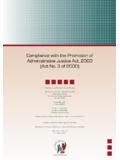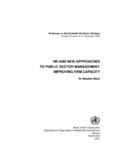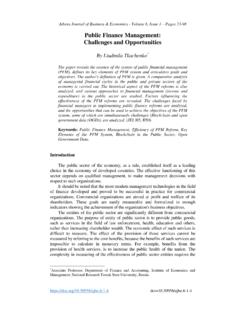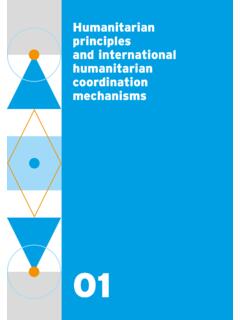Transcription of Public Service Reform in SA: Key Challenges of Execution ...
1 1 Public Service Reform in SA: Key Challenges of Execution Dr Yvonne Muthieni Introduction This paper explores the key Challenges to building a capable development state in SA, as articulated in the National Development Plan (NDP). These Challenges stem not only from a lack of capacity, but from a lack of coherence in framing the agenda and key success factors of a capable development state. The debate on state literature has evolved considerably from the Weberian analysis of examining state bureaucracies from a rationalist perspective focusing on the presence/absence of a coherent and hierarchical organisational logic, its efficiency and effectiveness and the existence/non-existence of a meritocratic professional bureaucracy insulated from day to day political interference (see van Bockel & Noordegraaf 2006). Later literature began examining the capability of the state with reference to its historical location in the existing political economy the periodization of statehood from colonialism to modernity, class formation and political cohesion (Evans 1997; Houston & Muthien 2000).
2 More recently, state literature has examined the capability of the state against the trajectory of democratisation and/or development (Evans 1989). Finally, there has been a closer scrutiny to the mechanics of the state engine with the growth of managerialism centred in the rise of New Public Administration (Schwella 1991; Muthien 2000). All of these theories in essence present a mosaic of analyses of various angles of state operations. For the purposes of this paper, state capability will be assessed through the level of expertise and professionalism, the governance of accountability, the effective design of organisational systems and processes, the level of skills and the quality of leadership; drawing on a hybrid of perspectives of state theory. State capability in SA will also be examined through the prism of Public sector Reform and discourses around the development to date. Public sector Reform Public sector Reform in SA has come a long way since 1994 from a highly centralised command and control function to a more decentralised function at 3 tiers of government with devolved authority to national departments, provinces and local authorities.
3 The National Development Plan (NDP) affirms this decentralisation and goes further to make a bold call for devolving more power to the metros at local government level. As evident in the dominant post-apartheid discourse since 1994, the paradigm of Public sector Reform has evolved from Democratisation & Transformation of the State Machinery (1994-2004) to 2 Building a Development State (2005-2013) However, numerous Public sector analysts have observed that South Africa still lacks a coherent model of Public sector Reform and Public management (Chipkin & Lipietz 2012; Muthien 2013). It is important to emphasize that SA is not a failed state . We have a functioning judicial system, legislature, state bureaucracy and executive. Moreover, we have pockets of excellence in terms of institutions, people and departments. Some authors have argued that the Mandela government inherited and reproduced the apartheid bureaucracy without much change (see L Picard 2005).
4 That is far from the truth. In fact the Public Service Commission mandated by President Mandela to restructure the fragmented apartheid Public services, undertook a complete abolition of all departments and established new departments with revised organisational structures and mandates. Management had to apply for the newly created positions and the PSC had to approve all senior appointments to uphold the merit principle. Furthermore there was a complete overhaul of occupational classification whereby approximately 284 occupational classes were reclassified into 16 broad bands and Occupational Specific Dispensations (OSDs) for scarce skill and highly qualified professional classes were introduced. The discriminatory grading and remuneration system was abolished and overhauled. Not to mention the complex devolution of authority, laws and staffing to 9 new provincial governments (Y Muthien 2000; PSC 1997). Since 1994 there has been considerable innovation in organisational design, management practices, Public policy and law making emanating from the new Constitution.
5 The Constitutional Court as the highest authority and ultimate safeguard for citizens against arbitrary rule gave rise to a new constitutionalism and continues to function without fear, favour or prejudice . It is also important to recognise that the apartheid state was partially failing in terms of policy coherence and consistency, delivery and fragmentation of administration, as well as a waning commitment to upholding apartheid in its dying years. The state that Nelson Mandela thus inherited was not efficient, effective or capable to serve the needs of the population. The building of a capable democratic state therefore required a concerted and coordinated effort on a scale hitherto unprecedented, since the large-scale civil Service Reform of the Mandela era. To understand the key Challenges facing the new democratic state, it is useful to examine its vision of a capable development state, its mode of delivery and the factors that would determine its success.
6 Vision of a Capable Development State 3 The new Public Administration Management Bill (PAM) of 2013 expresses the current vision and mandate of government: The emerging SA development state is democratic, non-racial, interventionist, redistributive, pro-poor, people-centred and participatory. (PAM 2013:122) The Bill creates a single Public Service that harmonises Public Service conditions while maintaining the decentralised structures and devolution of power enacted in 1999. The NDP recognises the failure of Public administration/management and reasserts that Public services are uneven and often of poor quality and despite huge strides in policy formation, the state lacks the capability to implement key policy programs . It is thus not surprising that the NDP recommends: Focusing on key capabilities of people and the state. Building a capable and developmental state. Encouraging strong leadership throughout society to work together to solve problems (NPC 2013) In framing the vision of a capable development state, government has defined its end state but not what its key attributes or markers of success should be.
7 New Managerialism as the Means to Deliver Development In sync with global theoretical shifts, the new Public management paradigm became rooted in the transformation discourse of the new SA state (Schwella 1991; Houston & Muthien 2000; Chipkin 2011). This saw an unprecedented rise of managerialism through the appointment of highly qualified professional managers at executive level, alongside experienced Weberian apartheid and bantustan bureaucrats. Between 1993-2001, the number of managers in the Public Service increased from 24,000 to 70,000 (PSC 2010). The new technocrats embraced international best practice and set about to transform and democratise the post-apartheid state by putting in place the new structures of government and enshrining democratic principles and values in the new Constitution. The new Public management ethos saw the unbundling of the highly centralised hierarchical policy and administration functions and introduced greater managerial autonomy by devolving executive decision-making to cabinet ministers and line-function heads of departments and agencies (Muthien 2000) However, the new managerialism was selectively embraced and hardly made its way through the ranks of the newly reconstituted management cadre.
8 This added to a lack of coherence in Public administration and created contradictory practices in Service delivery. Furthermore the 4 new Public management model was not consistently adopted across government departments horizontally or vertically across the 3 spheres of government. Nevertheless the post-apartheid state was able to draw the fragmented bureaucracies into a single Public Service with an overarching goal. The question remains whether the new managerialism best served the Reconstruction & Development Plan (RDP) agenda of the immediate post-apartheid state, or whether it was a stretch too far? Thus the second phase of state development in SA would focus more specifically on creating a Development state. The Rise of the Development State While the discourse of development was embedded in the post-apartheid state at the outset, the turn to developmentalism was sharpened by President Mbeki as an instrument to create a step ladder between the first and second economies in order to make economic growth more inclusive and reduce poverty (Powell 2012).
9 The success of the Asian Tigers were considered exemplary in delivering accelerated economic growth (see White & Wade 1984). However, the development state model was coupled by fiscal austerity and monetary constraint, framed in the Growth, Employment & Redistribution (GEAR) policy; which was more reminiscent of structural adjustment than redistributive development. As it stands, GEAR failed to deliver the levels of economic growth required for redistributive justice (Calitz 1997). Ultimately the success of the Asian Tigers rested on the confluence of different economic conditions, strong interventionist leadership, and the mobilisation of a more cohesive population behind a nation-wide development campaign. South Africa, with its history of economic marginalisation, high levels of poverty and inequality, lack of social cohesion born from its violently divided past, would require an extraordinary effort to emulate the success of the Asian Tigers.
10 In the next few sections we examine the contradictory modalities of creating a development state to deliver on the state objectives of economic growth, poverty eradication, job creation, reduction of income inequality and Service delivery. The Making of Political vs. Professional Appointments In executing its development mandate, the success of both Weberian and New Public Management bureaucracies relies on a highly skilled and deeply experienced professional administration. The blend of both old guard and new age sets of skills and experience into a single Public Service produced uneven outcomes in Service delivery. The new model of Public administration introduced in 1994 by the then Executive Public Service Commission (PSC) was forged through a hybrid of four contradictory models of 5 administrative leadership by blending political appointees/ deployees with old guard civil Service mandarins, agency specialists/technocrats, and corporatist managers (Muthien 2000; Chipkin & Lipietz 2012).



















